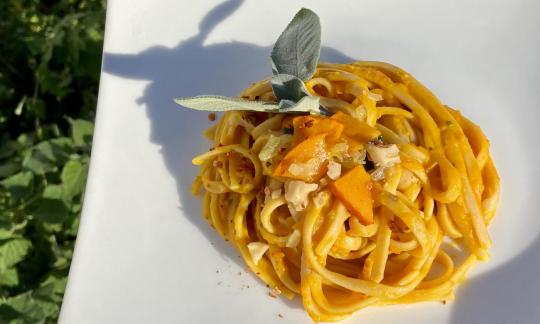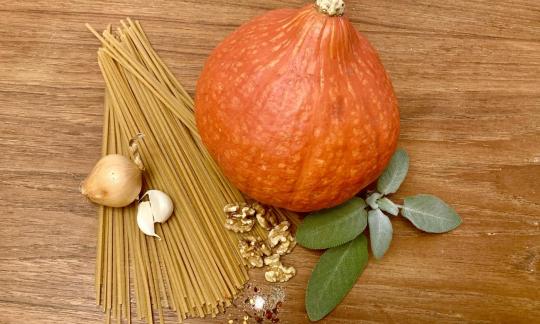Creamy oil-free whole grain linguine with pumpkin and sage
vegan
Ingredients (for servings, )
| 18 oz | Hokkaido pumpkins (Hokkaido pumpkins) |
| 1 | Onions, raw (organic?) (3.9 oz) |
| 4 cloves | Garlic (organic?) (0.42 oz) |
| 8 leaves | Sage, common (medicinal sage, kitchen sage) (0.04 oz) |
| ½ tsp, ground | Black pepper (organic?, raw?) (0.04 oz) |
| 1 dash | Table salt (table salt, raw?, organic?) (0.01 oz) |
| ½ tsp | Chili flakes (raw?, organic?) (0.08 oz) |
| 14 oz | Whole grain spaghetti, vegan (organic?) |
| 1 ¾ oz | Walnuts (tree nuts), raw (organic?) |
Equipment
- hand-held blender / immersion blender
- skillet (frying pan)
- stove
- saucepan
- sieve
Type of preparation
- cook
- chop or grind
- sauté
- sweat
- season to taste
- purée
- remove the skin
- sift
Preparation
Preparing vegetables
Wash the Hokkaido pumpkin and remove the seeds. Peel the onion and garlic and dice finely. Cut the sage into thin strips and halve them.500 g corresponds to about half a Hokkaido pumpkin.
Pumpkin: If you don't have Hokkaido pumpkin on hand, you can also use butternut squash. However, you should peel it first.
Preparing vegetables
Cut half of the pumpkin into large cubes and place in a pot of water (optionally add a little salt) and cook for about 10 minutes until soft. At the same time, cut the remaining pumpkin into thin slices and quarter them (alternatively, "carve" off slices of the same size).In a pan, lightly sauté the onions with 2 tablespoons of water (for 4 portions). After 2 minutes, add the garlic, pumpkin slices and sage and a little water if necessary and sauté for about 5 minutes until the pumpkin is cooked.
Meanwhile, start with the pasta.
Preparing whole wheat linguine
Put a large pot of lightly salted water on the boil. As soon as the water boils, add the linguine and cook according to the instructions on the packet. Then drain and allow to drain.Whole wheat pasta: You can also use whole wheat macaroni or whole wheat spaghetti instead of the whole wheat linguine actually mentioned in the title.
Finishing and serving the dish
Puree the cooked pumpkin with about half of the sautéed onion mixture. Add spices and season to taste. Optionally add a splash of lemon juice.Mix the pumpkin puree with the cooked linguine and divide between plates. Pour the fried pumpkin and onion mixture over the top and sprinkle with chopped walnuts.
|
Nutritional Information per person
Convert per 100g
|
2000 kcal | |
|---|---|---|
| Energy | 494 kcal | 24.7% |
| Fat/Lipids | 11 g | 16.2% |
| Saturated Fats | 1.3 g | 6.3% |
| Carbohydrates (inc.dietary fiber) | 90 g | 33.3% |
| Sugars | 7.3 g | 8.1% |
| Fiber | 13 g | 50.7% |
| Protein/Albumin | 18 g | 35.1% |
| Cooking Salt (Na:52.2 mg) | 133 mg | 5.5% |
| Essential micronutrients with the highest proportions | per person | 2000 kcal | |
|---|---|---|---|
| Min | Manganese, Mn | 3.8 mg | 188.0% |
| Min | Selenium, Se | 79 µg | 144.0% |
| Prot | Tryptophan (Trp, W) | 0.24 g | 98.0% |
| Min | Copper, Cu | 0.81 mg | 81.0% |
| Fat | Alpha-Linolenic acid; ALA; 18:3 omega-3 | 1.3 g | 63.0% |
| Elem | Phosphorus, P | 429 mg | 61.0% |
| Vit | Vitamin B3 (Niacin) | 9.6 mg | 60.0% |
| Prot | Isoleucine (Ile, I) | 0.73 g | 59.0% |
| Fat | Linoleic acid; LA; 18:2 omega-6 | 5.9 g | 59.0% |
| Prot | Phenylalanine (Phe, F) | 0.90 g | 58.0% |
Detailed Nutritional Information per Person for this Recipe
The majority of the nutritional information comes from the USDA (US Department of Agriculture). This means that the information for natural products is often incomplete or only given within broader categories, whereas in most cases products made from these have more complete information displayed.
If we take flaxseed, for example, the important essential amino acid ALA (omega-3) is only included in an overarching category whereas for flaxseed oil ALA is listed specifically. In time, we will be able to change this, but it will require a lot of work. An “i” appears behind ingredients that have been adjusted and an explanation appears when you hover over this symbol.
For Erb Muesli, the original calculations resulted in 48 % of the daily requirement of ALA — but with the correction, we see that the muesli actually covers >100 % of the necessary recommendation for the omega-3 fatty acid ALA. Our goal is to eventually be able to compare the nutritional value of our recipes with those that are used in conventional western lifestyles.
| Essential fatty acids | per person | 2000 kcal |
|---|---|---|
| Alpha-Linolenic acid; ALA; 18:3 omega-3 | 1.3 g | 63.0% |
| Linoleic acid; LA; 18:2 omega-6 | 5.9 g | 59.0% |
| Essential amino acids | per person | 2000 kcal |
|---|---|---|
| Tryptophan (Trp, W) | 0.24 g | 98.0% |
| Isoleucine (Ile, I) | 0.73 g | 59.0% |
| Phenylalanine (Phe, F) | 0.90 g | 58.0% |
| Threonine (Thr, T) | 0.53 g | 57.0% |
| Leucine (Leu, L) | 1.3 g | 53.0% |
| Valine (Val, V) | 0.82 g | 51.0% |
| Methionine (Met, M) | 0.29 g | 31.0% |
| Lysine (Lys, K) | 0.47 g | 25.0% |
| Vitamins | per person | 2000 kcal |
|---|---|---|
| Vitamin B3 (Niacin) | 9.6 mg | 60.0% |
| Vitamin B9, B11 (Folate, as the active form of folic acid) | 117 µg | 58.0% |
| Vitamin B1 (Thiamine) | 0.51 mg | 46.0% |
| Vitamin B6 (pyridoxine) | 0.62 mg | 44.0% |
| Vitamin A, as RAE | 200 µg | 25.0% |
| Vitamin B2 (Riboflavin) | 0.33 mg | 24.0% |
| Vitamin C (ascorbic acid) | 19 mg | 23.0% |
| Vitamin B5 (Pantothenic acid) | 1.2 mg | 21.0% |
| Vitamin B7 (Biotin, ex vitamin H) | 5.6 µg | 11.0% |
| Vitamin E, as a-TEs | 0.73 mg | 6.0% |
| Vitamin K | 4.4 µg | 6.0% |
| Essential macroelements (macronutrients) | per person | 2000 kcal |
|---|---|---|
| Phosphorus, P | 429 mg | 61.0% |
| Potassium, K | 994 mg | 50.0% |
| Magnesium, Mg | 170 mg | 45.0% |
| Calcium, Ca | 90 mg | 11.0% |
| Sodium, Na | 52 mg | 7.0% |
| Essential trace elements (micronutrients) | per person | 2000 kcal |
|---|---|---|
| Manganese, Mn | 3.8 mg | 188.0% |
| Selenium, Se | 79 µg | 144.0% |
| Copper, Cu | 0.81 mg | 81.0% |
| Zinc, Zn | 3.7 mg | 37.0% |
| Iron, Fe | 4.9 mg | 35.0% |
| Iod, I (Jod, J) | 0.95 µg | 1.0% |
| Fluorine, F | 2.1 µg | < 0.1% |
The creamy oil-free whole grain linguine with pumpkin and sage is tasty and filling. It's very easy to prepare.
Nutrient profile: According to GDA guidelines, one portion of this dish provides almost 200% of the essential trace element manganese and around 80% of its copper. It also contains many essential amino acids, such as tryptophan, which is 100% covered. However, some of the heat-sensitive ingredients are lost during the cooking process, which slightly reduces the amount per portion. The ratio of omega-6 to omega-3 fatty acids is 4:1, which is below the maximum recommended ratio of 5:1.
You can find further information on this topic at the following link: Vegans often eat unhealthily. Avoidable nutritional errors .
Hokkaido pumpkin: Unlike most other pumpkins, the skin of the small Hokkaido pumpkin, which weighs only 1-2 kg, is eaten as it becomes soft when cooked. The flesh has a stable consistency, is low in fibre and has a slightly nutty flavour. It owes its orange colour to the high levels of beta-carotene it contains, which our body can convert into vitamin A. It also contains large amounts of vitamins B1, B2 and B6, vitamins C and E as well as folic acid, magnesium, iron and phosphorus.
Walnuts: In Central Europe, the common walnut ( Juglans regia) is particularly important. Of all known nuts, the walnut has the highest proportion of alpha-linolenic acid (ALA). It also has health benefits thanks to its high levels of tocopherols (forms of vitamin E) and many trace elements.
Sage: The main active ingredients in sage include essential oils containing thujone, linalool and cineole. Sage is said to help with digestion after eating fatty foods and to help against flatulence.
Amount of salt and oil: We have deliberately left out oil for health reasons. We have not given any information on the amount of salt, as individual needs vary greatly. You decide for yourself, but we recommend keeping the salt content as low as possible. It takes around 3 months to get used to a lower salt content, but you will also benefit from this change in terms of taste. You can find more information on this topic in the book we describe in detail: Salt Sugar Fat by Michael Moss.
Whole wheat pasta: You can also use whole wheat macaroni or whole wheat spaghetti instead of the whole wheat linguine actually mentioned in the title.
Pumpkin: If you don't have Hokkaido pumpkin on hand, you can also use butternut squash. However, you should peel it first.






